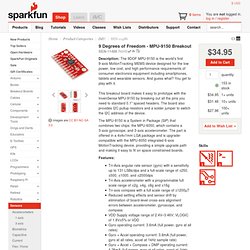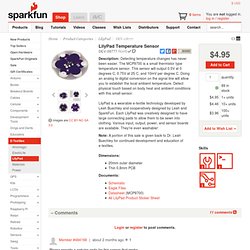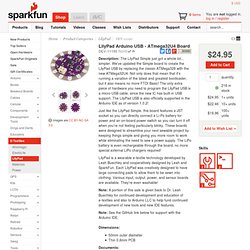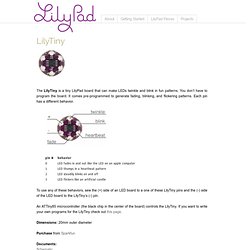

9 Degrees of Freedom Breakout - MPU-9150 - SEN-11486. Description: The 9DOF MPU-9150 is the world’s first 9-axis MotionTracking MEMS device designed for the low power, low cost, and high performance requirements of consumer electronics equipment including smartphones, tablets and wearable sensors.

And guess what? You get to play with it. This breakout board makes it easy to prototype with the InvenSense MPU-9150 by breaking out all the pins you need to standard 0.1" spaced headers. The board also provides I2C pullup resistors and a solder jumper to switch the I2C address of the device. The MPU-9150 is a System in Package (SiP) that combines two chips: the MPU-6050, which contains a 3-axis gyroscope, and 3-axis accelerometer. BITalino - BioMedical Development Kit - DEV-12750. Description: Introducing the BITalino, a (comparatively) low cost biomedical data acquisition dev board that allows you to create projects using physiological sensors and tools.

Each BITalino is presented in a “ProtoSnap style” making it able to be programmed as a whole board or snapped apart for use in future projects. This dev board also has no shortage of programming APIs which include Python, Java, Android, and more. XBee Buying Guide. XBee Buying Guide Welcome to the wireless world of XBee. Maybe you’ve heard of it, maybe you haven’t, either way you are in for a fun ride.
XBees are tiny blue chips that can communicate wirelessly with each other. They can do simple thing like replacing a couple of wires in serial communication, which is nice when you want to make a remote for your paintball vehicle. But which of the dozen or so modules do you want? There are lots of different types of modules which we are going to go over, but one of the nice things about these is that all the modules regardless of the series or type have similar pinouts.
What's an XBee, what's a Zigbee, what's a Bumblebee? XBee – According to Digi “XBee modules are embedded solutions providing wireless end-point connectivity to devices. Series What? XBee Series 1 (also called XBee 802.15.4) - These are the easiest to work with, they don’t need to be configured, although they can benefit from it. Antenna, Antennas, Antennae...
Xbee Compatible Devices. LilyPad Temperature Sensor - DEV-08777. Description: Detecting temperature changes has never been easier.

The MCP9700 is a small thermistor type temperature sensor. This sensor will output 0.5V at 0 degrees C, 0.75V at 25 C, and 10mV per degree C. Doing an analog to digital conversion on the signal line will allow you to establish the local ambient temperature. Detect physical touch based on body heat and ambient conditions with this small sensor. LilyPad is a wearable e-textile technology developed by Leah Buechley and cooperatively designed by Leah and SparkFun. Flex Sensor 2.2" - SEN-10264. LilyPad Arduino USB - ATmega32U4 Board - DEV-11190. Description: The LilyPad Simple just got a whole lot... simpler.

We've updated the Simple board to create the LilyPad USB by replacing the classic ATMega328 with the new ATMega32U4. Not only does that mean that it's running a variation of the latest and greatest bootloader, but it also means no more FTDI Basic! The only extra piece of hardware you need to program the LilyPad USB is a micro-USB cable, since the new IC has built-in USB support. The LilyPad USB is also officially supported in the Arduino IDE as of version 1.0.2!
Just like the LilyPad Simple, this board features a JST socket so you can directly connect a Li-Po battery for power and an on-board power switch so you can turn it off when you're not feeling particularly blinky. LilyPad is a wearable e-textile technology developed by Leah Buechley and cooperatively designed by Leah and SparkFun.
Note: A portion of this sale is given back to Dr. Note: See the GitHub link below for support with the Arduino IDE. Dimensions: Documents: LilyPad Light Sensor - DEV-08464. AVR 8 Pin 20MHz 8K 4A/D - ATtiny85 - COM-09378. LilyPad Arduino. The LilyTiny is a tiny LilyPad board that can make LEDs twinkle and blink in fun patterns.

You don’t have to program the board. It comes pre-programmed to generate fading, blinking, and flickering patterns. Each pin has a different behavior. To use any of these behaviors, sew the (+) side of an LED board to a one of these LilyTiny pins and the (-) side of the LED board to the LilyTiny’s (-) pin.